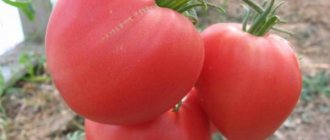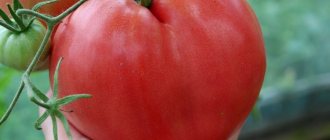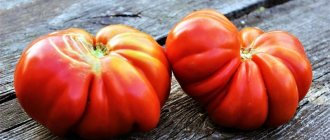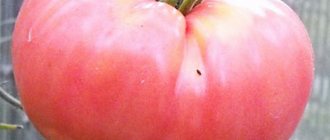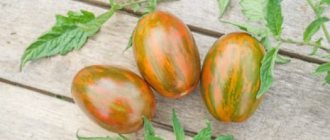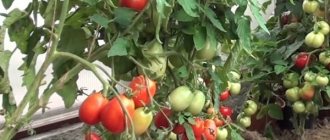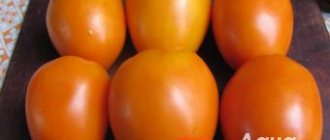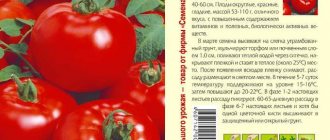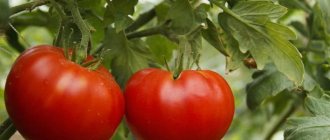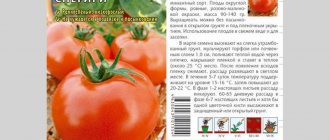It would be more correct to call the tomato Black Heart of Brad the Heart of Brad, because it was created by an American breeder named Brad Gates and gave it to gardeners with all his heart. In Russia, the variety is considered exotic, but reviews about it are mostly good.
| Height | Landing location | Ripening time | Fruit color | Fruit size | Origin | Fruit shape |
| Tall | Greenhouse | Mid-season | Bicolor | Large | Variety | Round |
Description of the variety
Tomato Black Heart Breda is an indeterminate variety; it has unlimited stem growth. Black heart - mid-season tomatoes. Ripening period is 90-130 days after seed germination.
The fruits set and grow until the end of the growing season. They ripen perfectly after being picked from the bush, without losing their taste properties. The bush is powerful, not very branched, and can grow up to 180 cm in height.
With proper care, fruits are formed on each tier. Clusters of 6 or more fruits are formed. Tomatoes are regularly shaped like a heart, but can be round or elongated. Color – burgundy-black, with a purple tint. There is a green spot near the stalk, from which beautiful streaks extend to the middle of the fruit. The seed chambers are not large, the fruits are quite fleshy.
The variety is not a hybrid, so tomatoes can be left for seeds next year.
Possible problems with diseases and pests
Often, the Black Heart Breda variety, according to reviews, characteristics, and descriptions, has a problem with leaf deformation. Curling is most often due to uneven watering. The cause may also be a deficiency of certain substances. If necessary, conduct a soil test. If this is not possible, use complex mineral fertilizer and change the irrigation regime.
Interesting. The tomato plant has good immunity to viral diseases.
Possible manifestations of surface rot. In the early stages, it is important to remove the affected bushes and treat the soil with a disinfectant.
Insecticidal soap solutions, timely weeding or manual collection of insects if the infestation is minor help in pest control.
Growing seedlings
Seedlings begin to be planted from mid-February to early March. The seeds are planted in the soil to a depth of about 3 cm. If the seeds are purchased, they do not require special processing. If you have your own, then it is advisable to treat them with a solution of potassium permanganate, then rinse with water. After the first two leaves have grown, the seedlings are picked, that is, planted in separate pots or cassettes.
Next, it is recommended to carry out complex fertilizing 2-3 times - add humus and mineral supplements. In order for seedlings to grow strong, they must be hardened off. To do this, the sprouts are taken out onto the balcony or a window is opened, gradually lowering the temperature and increasing the time spent in the air.
Planting and watering
This variety is recommended for cultivation both in open ground and in greenhouses. Seedlings are transferred to heated greenhouses from the beginning of April, to unheated ones - in early or mid-May. The sprouts are transferred to open ground from mid-May to early June. It is advisable to plant no more than 2-3 sprouts per 1 m², although if the plant is formed into one stem, the planting can be made more dense.
Tomatoes need to be watered regularly, with small volumes of warm water or drip irrigation.
Watering must be done so that water does not get on the leaves.
Feeding
It is recommended to feed tomatoes with organic fertilizers. Immediately after being transferred to open ground, the seedlings need to be fed with diluted slurry of manure. If the seedlings do not have enough sun, you can add ash.
For proper development of bushes, the soil must be prepared in the fall by feeding it with manure. Then apply manure again plus superphosphate and potassium chloride before planting the seedlings.
To prevent damage to blossom end rot, which is typical for these plants, they are sprayed with a solution of calcium nitrate once a week. The procedure is carried out during the period of active fruit growth.
Garter
It is not necessary to tie up tomatoes, but it is better to tie them up. Branched bushes may simply not withstand the weight of the fruit and break, after which the entire plant will rot quite quickly. The garter of the bushes is done after flowering, during the period when the fruits begin to set.
For support, you can take pegs 3-4 cm high, 180-190 cm high. The support can be made lower, depending on the height of the bushes.
To ensure plant ventilation, you can remove some of the leaves. This will reduce the risk of fungal diseases and increase the access of sunlight to the fruit.
Bush care
What care is needed for plantings:
- Watering. It is necessary to water the plantings regularly, but moderately, avoiding excessive soil moisture. Use warm water for watering. Experienced gardeners recommend installing a drip irrigation system to prevent water from getting on the foliage and stem;
- Formation and stepsoning. Form a bush into one stem, removing all excess stepsons. To improve the ventilation of the bushes, it is necessary to tear off all excess and lower leaves, but no more than 2-3 leaves per day. This operation also reduces the risk of fungal diseases and increases the access of light to the fruits;
- Feeding. Tomato responds well to the application of organic fertilizers. 10 days after transplantation, the plants are fed with slurry diluted in water. During the season, 3 to 4 feedings are carried out. It is recommended to alternate organic and mineral complexes;
When there is a lack of sunlight, wood ash is added.
- Tying. Since the plant is tall with heavy fruits, the procedure is mandatory. Tied to trellises to prevent branches from breaking off;
- Loosening. After each watering, loosen the soil. This will not only avoid the formation of a crust on the surface of the earth, but also saturate the root system with oxygen.
Stepsoning
There are several different opinions regarding stepsoning:
- Remove all the shoots between the leaves, except the top ones, and form a bush into 1 stem. The advantage of the method is the ability to plant more bushes in a limited area. Minus - you need a high greenhouse.
- Leave the stepson under the first inflorescence, secure it by pinching it after the development of 1-2 flowering clusters. Pros - fruit set at a lower level, the bush is formed lower. Disadvantages: weight loss, additional tying, and the need to pinch an additional stem.
- Form several stems. Leave the stepsons under the first, second and third inflorescences. Cut other growing stepsons 1-2 times a week until they have grown to 5-7 cm. This makes it possible to monitor the number of fruits for more successful ripening and avoid deterioration of the harvest. Experienced plant growers recommend leaving 5-7 inflorescences on the stem. The fewer trusses there are, the larger the tomatoes can grow.
- Pinch the crown of the first trunk after the development of 5-7 clusters. Cut off the crown of the second stem after the first cluster appears.
Black Heart of Brad: video
The Black Heart of Breda tomato stands out for its exceptional aroma and taste, large fruit size and beautiful, unusual color. The characteristics and description of this variety help you decide whether it is worth trying to grow this miracle on your site.
Tall, indeterminate: growth continues even when a flower cluster appears at the top of the central shoot. Mid-season, tomatoes ripen 90-130 days after seed germination. Resistant to temperature changes, moderately unpretentious. The ovaries form and develop throughout the growing season.
The fruits ripen well when removed from the bush, while maintaining their taste. In favorable conditions, the bush grows up to 180 cm, ovaries are formed in each internode. Drooping foliage. The fruits of black tomatoes can be left to produce their own seeds, since the variety is non-hybrid.
The basic shape is heart-shaped, regular, and can also be elongated or round. Tomatoes have a black-burgundy color and a purple tint. The weight of tomatoes reaches a kilogram or more. The pulp is dense, fleshy. The taste of Black Heart Breda tomatoes is unique. Fragrant, sweet, subtle, with a hint of tropical fruit.
Tomatoes are suitable for fresh consumption, making salads, juices, and sauces. Black tomatoes are considered aphrodisiacs, and in the old days they were even called apples of love.
The variety is suitable for cultivation in greenhouses. In areas recommended for zoning, tomatoes are grown in open ground. This is the Russian south, the middle zone. In addition, tomatoes have proven themselves positively in the Urals and in the Siberian region. Productivity is above average. In open ground conditions, 1 bush produces 5-7 kg of fruit; with a greenhouse growing method, this figure may be higher. The variety shows resistance to many nightshade diseases, especially late blight.
Soil requirements are standard for all tomatoes: it should be loose, light and nutritious. Regular watering with warm water in small volumes or drip irrigation at the root is recommended. Seeds for seedlings are sown from mid to late February, as well as in early March. Before embedding into the soil, they are disinfected by soaking in a solution of potassium permanganate, then washed with clean water.
The emerging seedlings dive from the moment two true leaves appear. Fertilizing is carried out systematically with complex fertilizers. Before planting in a permanent place, seedlings must be hardened off.
Plants are planted in heated greenhouses from the beginning of April, in unheated ones - no earlier than the beginning - mid-May. Planting in open ground occurs from the moment the threat of return frosts ceases.
The variety is responsive to the application of organic fertilizers. After planting, it is recommended to water the seedlings with diluted slurry. When there are few sunny days, plants are fed with ash. For maximum yield, it is recommended to prepare the land in the fall by adding organic matter. The bush can withstand the weight of the fruit, but for insurance it is advisable to tie it up.
To ensure access to light for plants to fully develop, good ventilation to prevent fungal diseases, excess leaves are removed. As evidenced by reviews from gardeners, opinions on the formation of the Black Heart of Breda tomato bush are divided.
source
More and more unusual varieties of tomatoes can be seen in the beds of gardeners in our country: black and white, purple and blue. Some of them are gigantic, like watermelons, others are small, like cherries.
Tomato Black Heart - medium size. These are juicy, sweet black and burgundy tomatoes with an amazing aroma. The variety is quite productive, but requires care. But for all its outwardly unusual appearance, Black Heart is successfully grown on domestic farms and summer cottages.
Tomato Black Heart Breda is an indeterminate variety; it has unlimited stem growth. Black heart - mid-season tomatoes. Ripening period is 90-130 days after seed germination.
The fruits set and grow until the end of the growing season. They ripen perfectly after being picked from the bush, without losing their taste properties. The bush is powerful, not very branched, and can grow up to 180 cm in height.
With proper care, fruits are formed on each tier. Clusters of 6 or more fruits are formed. Tomatoes are regularly shaped like a heart, but can be round or elongated. Color – burgundy-black, with a purple tint. There is a green spot near the stalk, from which beautiful streaks extend to the middle of the fruit. The seed chambers are not large, the fruits are quite fleshy.
Among the many bushes of the Black Crimea variety, the experienced American breeder Brad Gates discovered and stabilized the seeds of the Black Bull's Heart tomato on his farm, which was then named in honor of the breeder - Brad's Black Heart. The variety was developed in California in the early 2000s.
Tomatoes of this variety are grown both in open ground and in greenhouses. They are recommended for planting in the southern part and central zone of the Russian Federation, but they grow well in the Urals and Siberia.
The ripening period of the vegetable is from 90 to 130 days. The productivity of the variety is high. The average weight of a tomato is 200-300 grams, the weight of individual specimens can reach up to 500 grams. When cultivated in heifers, higher yields can be achieved.
Seedlings begin to be planted from mid-February to early March. The seeds are planted in the soil to a depth of about 3 cm. If the seeds are purchased, they do not require special processing. If you have your own, then it is advisable to treat them with a solution of potassium permanganate, then rinse with water. After the first two leaves have grown, the seedlings are picked, that is, planted in separate pots or cassettes.
Next, it is recommended to carry out complex fertilizing 2-3 times - add humus and mineral supplements. In order for seedlings to grow strong, they must be hardened off. To do this, the sprouts are taken out onto the balcony or a window is opened, gradually lowering the temperature and increasing the time spent in the air.
Tomatoes are planted in light, loose, nutritious soil. They love neutral or slightly acidic soil with a pH of 5.5 to 6.5.
This variety is recommended for cultivation both in open ground and in greenhouses. Seedlings are transferred to heated greenhouses from the beginning of April, to unheated ones - in early or mid-May. The sprouts are transferred to open ground from mid-May to early June. It is advisable to plant no more than 2-3 sprouts per 1 m², although if the plant is formed into one stem, the planting can be made more dense.
Watering must be done so that water does not get on the leaves.
It is recommended to feed tomatoes with organic fertilizers. Immediately after being transferred to open ground, the seedlings need to be fed with diluted slurry of manure. If the seedlings do not have enough sun, you can add ash.
For proper development of bushes, the soil must be prepared in the fall by feeding it with manure. Then apply manure again plus superphosphate and potassium chloride before planting the seedlings.
To prevent damage to blossom end rot, which is typical for these plants, they are sprayed with a solution of calcium nitrate once a week. The procedure is carried out during the period of active fruit growth.
It is not necessary to tie up tomatoes, but it is better to tie them up. Branched bushes may simply not withstand the weight of the fruit and break, after which the entire plant will rot quite quickly. The garter of the bushes is done after flowering, during the period when the fruits begin to set.
For support, you can take pegs 3-4 cm high, 180-190 cm high. The support can be made lower, depending on the height of the bushes.
There are several different opinions regarding stepsoning:
- Remove all the shoots between the leaves, except the top ones, and form a bush into 1 stem. The advantage of the method is the ability to plant more bushes in a limited area. Minus - you need a high greenhouse.
- Leave the stepson under the first inflorescence, secure it by pinching it after the development of 1-2 flowering clusters. Pros - fruit set at a lower level, the bush is formed lower. Disadvantages: weight loss, additional tying, and the need to pinch an additional stem.
- Form several stems. Leave the stepsons under the first, second and third inflorescences. Cut other growing stepsons 1-2 times a week until they have grown to 5-7 cm. This makes it possible to monitor the number of fruits for more successful ripening and avoid deterioration of the harvest. Experienced plant growers recommend leaving 5-7 inflorescences on the stem. The fewer trusses there are, the larger the tomatoes can grow.
- Pinch the crown of the first trunk after the development of 5-7 clusters. Cut off the crown of the second stem after the first cluster appears.
On average, tomatoes begin to be harvested 100 days after seedling germination. In open ground, up to 5-20 kg can be harvested from 1 bush, depending on the conditions in which the tomatoes were kept.
It is recommended to collect vegetables in warm, dry weather. The collected fruits must be dried, otherwise they will begin to rot after some time during storage.
Tomato Black Heart has many advantages, including:
- high productivity;
- resistance to most diseases;
- good ripening of fruits after picking;
- endurance;
- immunity to late blight fungus;
- resistance to heat and cold.
- need for care;
- susceptibility to blossom end rot.
In conclusion, we can say that Black Heart tomatoes are tasty, sweet tomatoes of extraordinary appearance. One bush can produce fruits of various weights and shapes. Tomatoes of this variety are distinguished by their characteristic aroma, large fruit size and spectacular burgundy-black color.
Harvesting
On average, tomatoes begin to be harvested 100 days after seedling germination. In open ground, up to 5-20 kg can be harvested from 1 bush, depending on the conditions in which the tomatoes were kept.
It is recommended to collect vegetables in warm, dry weather. The collected fruits must be dried, otherwise they will begin to rot after some time during storage.
Tomatoes of this variety ripen well after being picked from the bush and are well transported. To ripen, green tomatoes are placed in a box in one layer in a room with a temperature of +10-12? C and a humidity of about 80%.
Pros and cons of the variety
Tomato Black Heart has many advantages, including:
- high productivity;
- resistance to most diseases;
- good ripening of fruits after picking;
- endurance;
- immunity to late blight fungus;
- resistance to heat and cold.
Disadvantages of the variety:
- need for care;
- susceptibility to blossom end rot.
In conclusion, we can say that Black Heart tomatoes are tasty, sweet tomatoes of extraordinary appearance. One bush can produce fruits of various weights and shapes. Tomatoes of this variety are distinguished by their characteristic aroma, large fruit size and spectacular burgundy-black color.
What gardeners say
Most vegetable growers who practiced growing tomatoes of the Black Heart Breda variety were satisfied with the results. The unusual color of the fruit, their impressive size, combined with excellent taste, leave few indifferent.
Gardeners note that when cultivating tomatoes in greenhouses, yields are significantly higher than when growing them in open areas. It is also recommended to form a bush into not one, but several stems.
The unusual appearance of the fruits, high taste and good yield far outweigh the inconvenience of growing them - the need to tie up the plant. In all other respects, this variety is undemanding; it only requires compliance with the basic rules of agricultural technology.
With a little effort, you can get a decent harvest of high-quality, full-fledged fruits with an atypical color. They will not only decorate the holiday table, but will also be useful for winter preservation.
